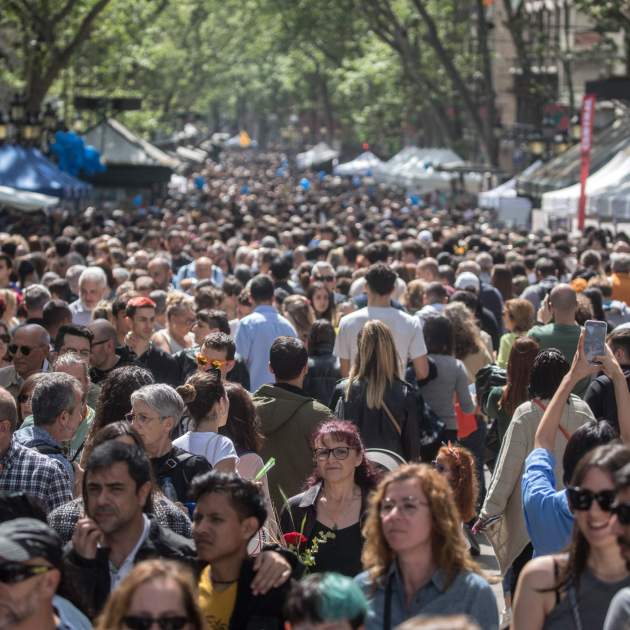Barcelona's most fabulous festive day, Sant Jordi, will have its crowning glory back this April 23rd: that is, after a few years in the background, La Rambla will once again be one of the central focuses of the epic Catalan celebration of books and roses. Booksellers' association La Cambra del Llibre has decided to recover one of the most emblematic spaces of the the festival in the Catalan capital, and the full length of the Rambla, from Canaletes at the top to Santa Mònica at the end, will offer rose stalls and book tables, in a day that even before it begins has broken records - for the number of stalls organized. As well, for the first time there will be a Sant Jordi presence in all seven districts of the city, while, as ever, the Diada in honour of Catalonia's patron saint will also be celebrated in towns and cities from the Ebre to the Empordà.
"We face Sant Jordi with optimism; last year we had a very good day, and we would be satisfied if we could have similar sales figures", explained Jordi Ferré, booksellers' representative. This April 23rd will be the first in recent years to fall on a working day, after the last edition, held on a Sunday, saw the launch of the "literary superblock", which brought together more than a million people in the Barcelona city centre. This year also comes with further new developments, and 2024 will be the first time that the Cambra has used a co-payment approach for bookstalls in the "professional area", a decision that has caused controversy with accusations of privatization and outsourcing of this popular Catalan festival. Despite that, there are 16 more requests for rose and book stalls than last year.
The Eixample area will once again host the largest number of stalls, with a total of 230 stands - 37 of them for roses. It will once again have its centre in Passeig de Gràcia and its transversal streets, from Gran Via up to Diagonal, with cross streets including Diputació, Consell de Cent, Mallorca, Provença, Rosselló, an extension to Còrsega and two sections of Diagonal to Balmes, connecting with the Rambla de Catalunya to create a walking circuit. One of the challenges is to improve the circulation of people and avoid overcrowding, especially during book signing periods.
But the protagonist area of the edition, at least for its historical impact, will once again be Ciutat Vella with La Rambla as the main literary and floral attraction, with 94 stalls. Thus, finally, the great symbolic value and cradle of the festivity is being recovered after its activity was suspended for Sant Jordi, first after the terrorist attacks of August 2017, and then due to the pandemic in later years. In addition, the connection with Passeig de Gràcia and Gran de Gràcia, will mean a line of books and roses will cross the city "from sea to mountain". As for other districts, Gràcia will have 26 stalls, Les Corts will have 9 and Sant Martí, 8. For their part, Sant Andreu and Sarrià will join the day with 6 and 4 stands respectively, making Sant Jordi the most decentralized until now
The co-payment controversy in the professional area of the book
Meanwhile, controversy has been generated in the build-up to this edition by the decision to apply co-payment for professional stalls, that is, obliging publishers and booksellers to pay an amount to place their stand in the professional areas - those organized by the Cambra. Despite the doubts, Èric del Arco, president of the Gremi de Llibreters (Booksellers Guild) explained that "the rate of registration has been faster and has increased, with more stalls than last year". The so-called "professionalized" zone, with 330 bookstores, publishers or entities that have already paid, gives the right to a series of advantages, such as electricity availability and user support. This, despite a controversy that has generated criticisms and a manifesto signed by hundreds of people against this payment initiative. "We believe that within the professional sector, with the explanations we have given, when we have explained it, people have understood our arguments", clarified the Booksellers Guild president, acknowledging that the initial communication of the plan through a press release was flawed. Éric del Arco has acknowledged that, after Sant Jordi, there will be a reflection to see how the model is progressing, although he has communicated that "co-payment is here to stay", and he noted that in fact less than 10% of the total stalls in Barcelona are affected by the co-payment demand.
Sant Jordi in the rest of Catalonia
April 23rd will of course be celebrated as usual in all the municipalities of Catalonia, a fact that demonstrates the strength and the spread of bookstores and literary culture throughout the country. In Badalona, for example, bookshops will set up in Plaça de Pompeu Fabra, while other entities will do so in Plaça de l'Ajuntament. In Cerdanyola del Vallès the focus will be in Plaça de l'Abat Oliva, apart from the stalls set up by each bookseller in front of their own bookshop, and in Vilafranca del Penedès there will be a focus in Rambla de Sant Francesc, with space for book signings by local authors managed by the city council. The provincial capitals will also be the epicentre of the most beautiful Catalan festive day of the year: Girona recovers its traditional celebratory place on the Rambla after Covid measures forced it to move elsewhere; Lleida will continue on Rambla Ferran and Avinguda de Francesc Macià; and Tarragona will gather in one of the sections of the Rambla, dedicated specifically to books.
